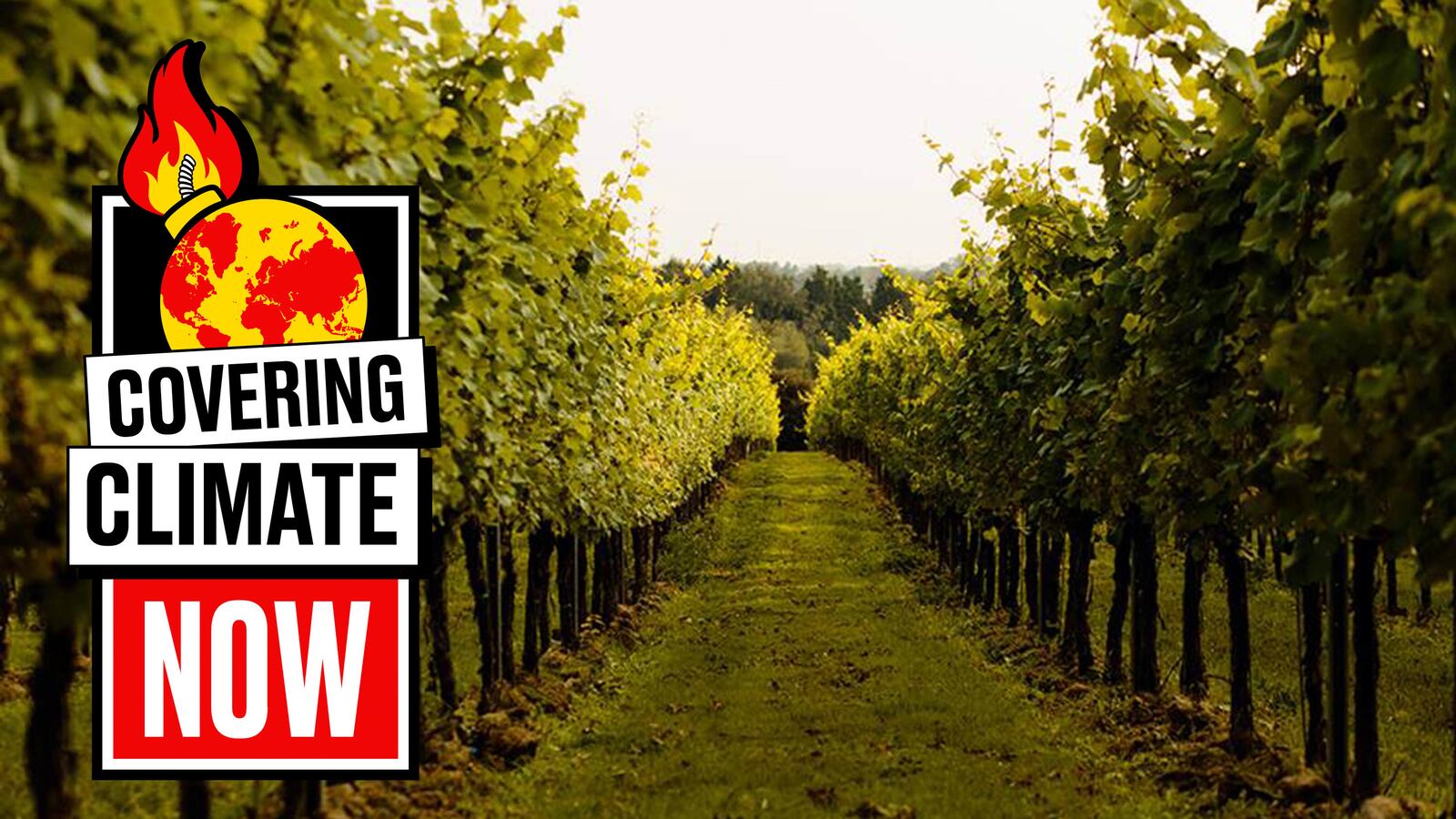This story is part of Covering Climate Now, a global collaboration of more than 220 news outlets to strengthen coverage of the climate story.
If I were a French winemaker and someone called me up and asked if I’d like to put my bottles up against a dark horse in a public tasting I’d balk.
You can’t blame me given the results of the so-called Judgment of Paris, where California wines trounced French ones in 1976 and, in the process, introduced America’s nascent wine industry to the world. I’d then politely request that they lose my phone number.
Perhaps Gallic optimism knows no bounds, which explains why in the spring of 2016, there was a tasting at a Paris bistro called Juveniles, where French Champagne makers faced off against vineyards in a relatively new region about which not much fuss had been made before. As I’m sure you can guess, the underdog prevailed.
But the winners weren’t from Napa or Sonoma or any well-known wine region but from England.
England.
According to an article in Drinks Business by Neal Baker, “a bottle of 2011 Gusbourne Rosé went up against a NV Ayala Rosé Majeur from Champagne, nine preferred the Gusbourne and five picked the Champagne. Half the tasters thought the English wine was Champagne.”
While the English certainly know how to drink bubbly, I was shocked that they also know how to make it.
Bartholomew Broadbent, the CEO of Broadbent Selections, which imports Gusbourne, put it to me thus: “Historically, wine would be shipped to the U.K. and then sold from there. As a result, the English developed a history of knowing about all wines.”

Locals in wine regions, meanwhile, know what they make, but not what their neighbors make, he explained. If you were in Burgundy or Bordeaux you could learn about the wines made there, but not wines from other regions. Burgundians didn’t know their Bordeaux, and vice versa. The lack of production in England meant that British oenophiles looked elsewhere for their wines, and learned about everything.
“Of course, the British are also wine adventurers,” Madeleine de Jean, the author of The Night Julius Caesar Invented Champagne, told me. “As for the shift in the growing regions, that might seem to indicate that France is no longer producing great Champagnes. But that is far from true. And in fact they are shifting into the Aube more and more for space and for really fine Pinot Noir.”
“As for the British sparkling wine industry,” she continued, “it was just a matter of time before what was in their blood, since those Celtic tribes and Caesar, returned to the surface. Of course, climate change was needed, too. It had been too cold and damp there.”
Mr. Broadbent agrees. The same chalky soil that is found in the Champagne region spreads through Sussex, Kent, and Hampshire, where most of the vineyards for the British sparkling wines are located. “The biggest reason that England is now making sparkling wines, which are equal, and in many cases better, than Champagne, is because the climate change has given the U.K. a perfect climate,” he says.
Traditionally, Champagne grapes struggle to ripen in the complicated and austere French climate—a steady temperature and rainfall coupled with a tendency to cold and dangerous frost snaps in spring and fall. The region gets about 1,650 hours of annual sunlight, significantly less than Burgundy or Bordeaux, which bathe in around 2,000 hours. I looked up the average sunlight in Essex, which is now 1,600 hours per year. The English countryside also, of course, offers plenty of cold rain and blustery conditions.
Ms. de Jean says that she started hearing about the possibility of English sparkling wine in the 1980s. She asked around, but no one she knew had ever tasted any. Although rumors seemed common, she asked around wine shops in London as recently as 2005, and while everyone had heard of vineyards in Kent and Sussex, she couldn’t find any wine on the shelf.
“Two years later wines from Kent, Sussex, and Essex were the rage,” she remembers.
“Nyetimber were the first to plant Chardonnay, Pinot Noir, and Pinot Meunier for the production of traditional method sparkling wines in 1989,” said Laura Rhys, MS, who works for Gusbourne. “Their first vintage was 1992. Other early pioneers were Camel Valley, Ridgeview and Bolney.”
At a recent wine tasting in London, there were nearly 50 producers showing sparkling wines.
Andrew Weeber took over the Gusbourne Estate in Kent in 2004 and planted the classic Champagne varietals mentioned above. “We plant predominantly Burgundian clones,” Ms. Rhys said, “and all the grapes used in our winemaking are sourced solely from Gusbourne vineyards.”

Gusbourne produces only single vintage wines. They age on lees for at least 36 months, and spend another three months on cork.
The result?
An exceedingly well-balanced glass of sparkling wine, with lots of bread yeast on the nose and notes of green apple skin and lemon oil on the tongue. It finishes crystal clear.
“Gusbourne appeals to me because it is more of a serious wine, like Pol Roger or Bollinger,” said Mr. Broadbent. “It is an excellent food wine.” (It’s interesting that he likens his brand to Pol Roger given that it was a favorite of Winston Churchill. Pol Roger even honored the former prime minister with its Churchill Cuvée, which is still available today.)
“The English have never really embraced English wine because it was nothing to be proud of,” said Mr. Broadbent, an Englishman who lives in America. “Though the English have a love of French wine, they have a love/hate relationship with the French. English sparkling wine is an excuse to say ‘in your face, France, we are better than you.’”
Climate change news is not good news and looking for positive angles is irresponsible, at best, but in the world of wine, there is a silver lining, and while it makes me feel like the Marquis de Sade, I’m here to suggest that we bring along some Champagne flutes to the cocktail party at the end of the world.

